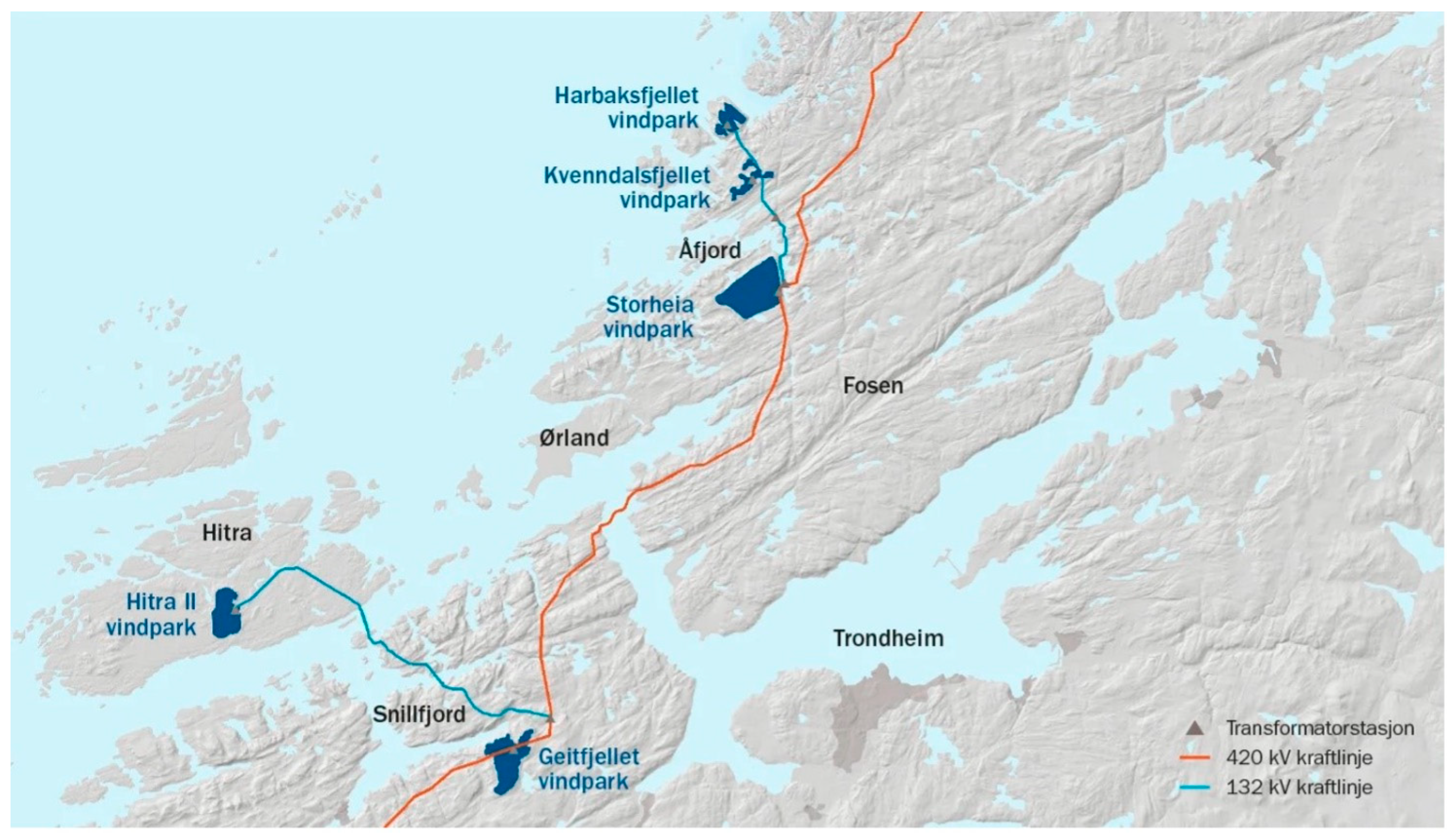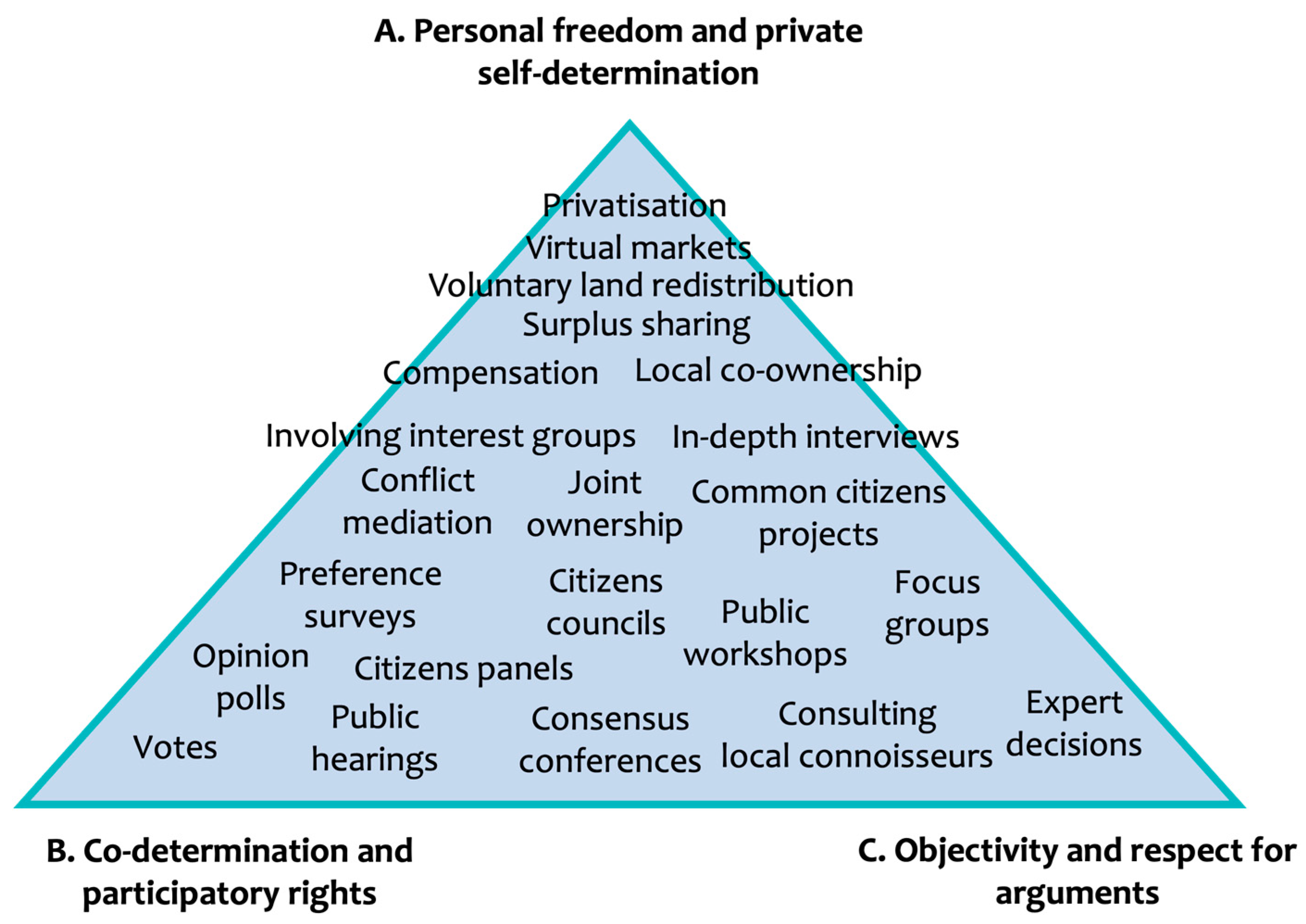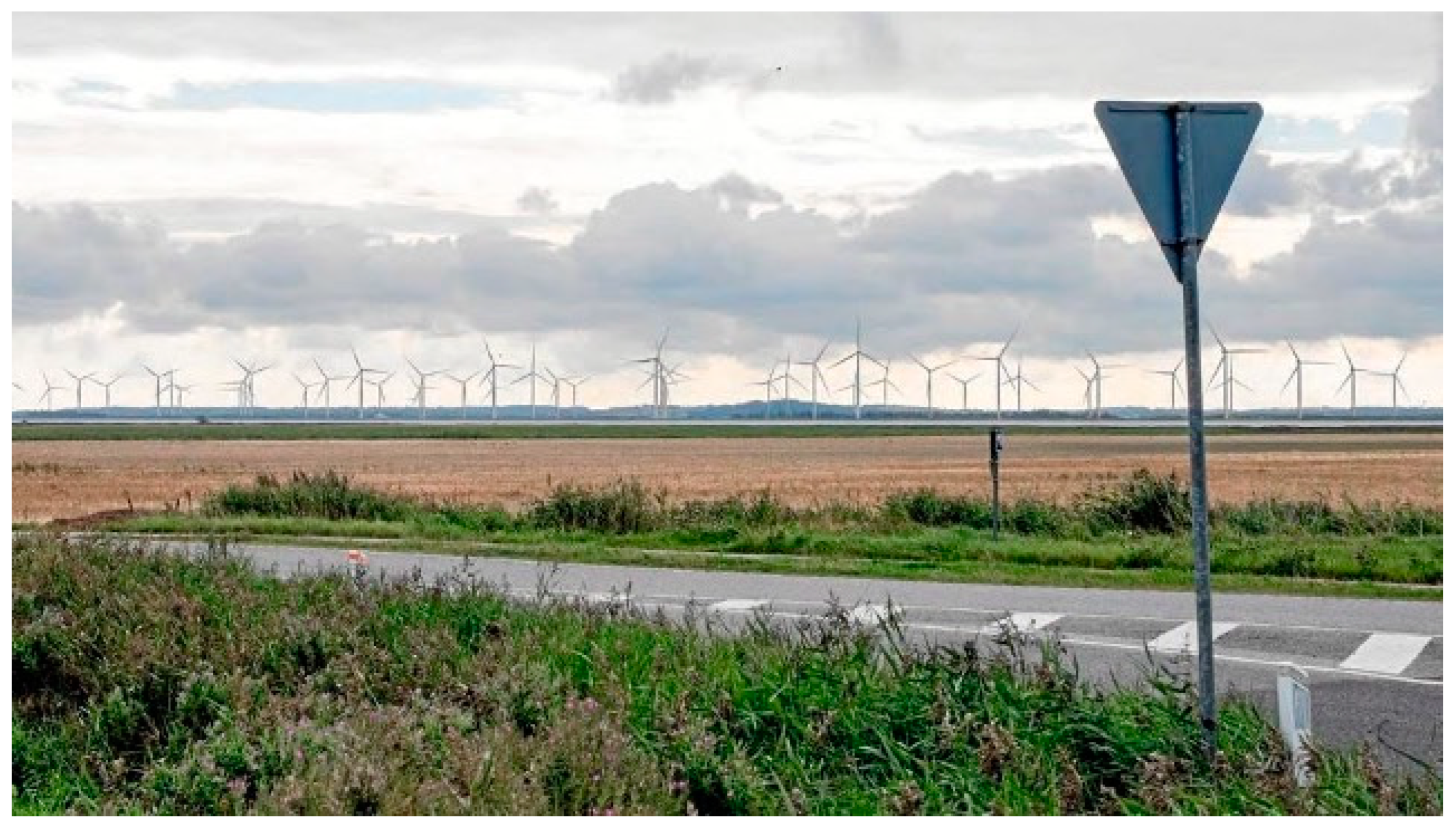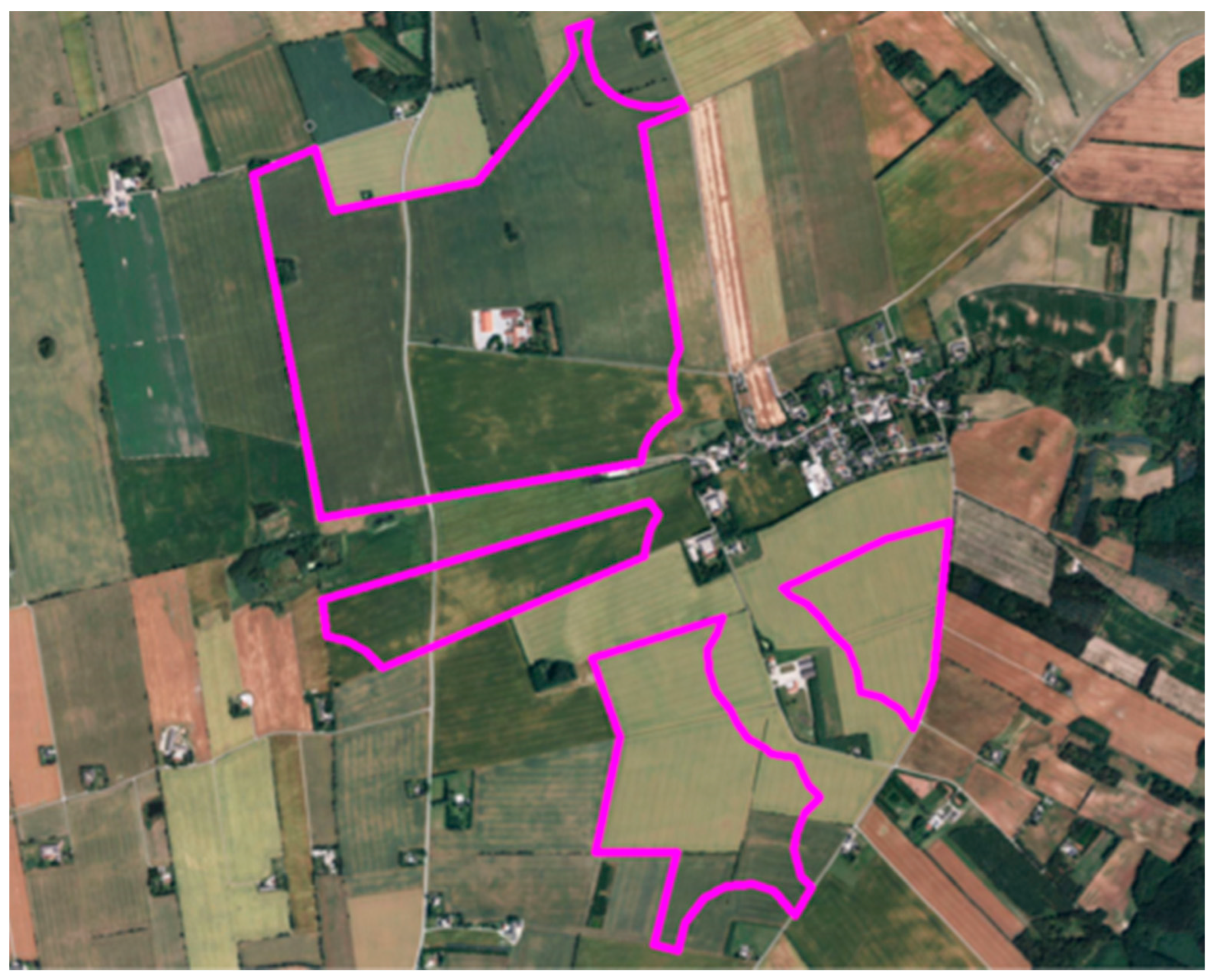Landscape Democracy and the Implementation of Renewable Energy Facilities
Abstract
1. Background
2. Purpose, Method, and Structure
3. The European Landscape Convention
4. Democratic Principles Seen in a Landscape Context
4.1. Personal Freedom and Self-Determination
4.2. Co-Determination and Participation
4.3. Objectivity and Impartiality
5. The Three Sets of Values in Practice
5.1. Private Self-Determination
5.2. Participatory Measures

5.3. Deliberative Measures
6. Decision Levels
7. Values Added and Subtracted
8. Concluding Remarks
Author Contributions
Funding
Data Availability Statement
Acknowledgments
Conflicts of Interest
References
- UN. Paris Agreement. United Nations. 2015. Available online: https://unfccc.int/sites/default/files/english_paris_agreement.pdf (accessed on 22 June 2023).
- EU. The European Green Deal; 11.12.2019 COM(2019) 640; EU: Brussels, Belgium, 2019. [Google Scholar]
- IEA. World Energy Outlook 2021; International Energy Agency: Paris, France, 2021. [Google Scholar]
- UNEP. Emissions Gap Report 2021: The Heat Is On—A World of Climate Promises Not Yet Delivered. Nairobi: United Nations Environment Programme. 2021. Available online: https://www.unep.org/resources/emissions-gap-report-2021 (accessed on 22 June 2023).
- Kirch Kirkegaard, J.; Cronin, T.; Nyborg, S.; Karnøe, P. Paradigm shift in Danish wind power: The (un)sustainable transformation of a sector. J. Environ. Policy Plan. 2021, 23, 97–113. [Google Scholar] [CrossRef]
- Karnøe, P. Dansk Vindmølleindustri—En Overraskende International Succès; Samfundslitteratur: Copenhagen, Denmark, 1991. [Google Scholar]
- Gipe, P. Wind Energy Comes of Age; John Wiley & Sons: New York, NY, USA, 1995. [Google Scholar]
- Van Est, R. Winds of Change: A Comparative Study of the Politics of Wind Energy Innovation in California and Denmark; International Books: Utrecht, The Netherlands, 1999. [Google Scholar]
- Beuse, E.; Boldt, J.; Mægaard, P.; Meyer, N.I.; Windeleff, J.; Østergaard, I. Vedvarende Energi i Danmark. En Krønike om 25 Opvækstår 1975–2000; Beuse, E., Boldt, J., Mægaard, P., Meyer, N.I., Windeleff, J., Østergaard, I., Eds.; Organisationen for Vedvarende Energi: Aarhus, Denmark, 2000. [Google Scholar]
- Jensen, I.K. Mænd i Modvind—Et Dansk Industrieventyr; Ib Konrad Jensen Forlag: Copenhagen, Denmark, 2015. [Google Scholar]
- Petersen, F. Da Danmark Fik Vinger. Vindmøllehistorien 1978–2018; Danmarks Vindmølleforening: Aarhus, Denmark, 2018. [Google Scholar]
- Arler, F. Renewables. In Ethics in Danish Energy Policy; Arler, F., Rüdiger, M., Sperling, K., Høyer Toft, K., Poulsen, B., Eds.; Routledge: London, UK, 2020; pp. 93–121. [Google Scholar]
- Council of Europe. European Landscape Convention and Explanatory Report; Strasbourg 19 July 2000, T-LAND (2000) 6; Council of Europe: Strasbourg, France, 2000. [Google Scholar]
- Tuan, Y.F. Space and Place. The Perspective of Experience; University of Minnesota Press: Minneapolis, MN, USA, 1977. [Google Scholar]
- Tuan, Y.F. Space and place: Humanistic perspective. In Philosophy in Geography; Springer: Berlin/Heidelberg, Germany, 1979. [Google Scholar]
- Tuan, Y.F. Topophilia: A Study of Environmental Perception, Attitudes, and Values; Prentice-Hall: Englewood Cliffs, NJ, USA, 1974. [Google Scholar]
- Cresswell, T. Place a Short Introduction; Blackwell Publishing: Hoboken, NJ, USA, 2004; Volume 14. [Google Scholar]
- Carys Swanwick and Land Use Consultants. Landscape Character Assessment: Guidance for England and Scotland TOPIC PAPER 6: Techniques and Criteria for Judging Capacity and Sensitivity. Landscape Character Assessment; The Countryside Agency & Scottish Natural Heritage: Cheltenham/Edinburgh, UK, 2002. [Google Scholar]
- Arler, F. A true landscape democracy. In Humans in the Land: The Ethics and Aesthetics of the Cultural Landscape; Arntzen, S., Brady, E., Eds.; Unipub Forlag: Oslo, Norway, 2008; pp. 75–99. [Google Scholar]
- Arler, F.; Mellqvist, H. Landscape democracy, three sets of values, and the connoisseur method. Environ. Values 2015, 24, 271–298. [Google Scholar] [CrossRef]
- Arler, F. Landscape democracy in a globalizing world: The case of Tange Lake. Landsc. Res. 2011, 36, 487–507. [Google Scholar] [CrossRef]
- Egoz, S.; Jørgensen, K.; Ruggeri, D. Landscape Democracy: A Path to Spatial Justice; Edward Elgar: Cheltenham, UK, 2018. [Google Scholar]
- Jones, M.; Stenseke, M. The European Landscape Covention: Challenges of Participation; Landscape Series Vol., 13; Jones, M., Stenseke, M., Eds.; Springer: Dordrecht, The Netherlands, 2011. [Google Scholar]
- US Congress. Declaration of Independence. 1776. Available online: https://www.archives.gov/founding-docs/declaration-transcript (accessed on 22 June 2023).
- US Congress. The Bill of Rights. 1791. Available online: https://www.archives.gov/founding-docs/bill-of-rights-transcript (accessed on 22 June 2023).
- UN. Universal Declaration of Human Rights; United Nations: New York, NY, USA, 1948. [Google Scholar]
- Raz, J. The Morality of Freedom; Oxford University Press: London, UK, 1986. [Google Scholar]
- Kymlicka, W. Contemporary Political Philosophy. An Introduction; Oxford University Press: Oxford, UK, 2001. [Google Scholar]
- Dahl, R. Democracy and Its Critics; Yale University Press: New Haven, CN, USA, 1989. [Google Scholar]
- Bohman, J.; Rehg, W. Deliberative Democracy: Essays on Reason and Politics Edited. Deliberative Democracy; MIT Press: Cambridge, MA, USA, 1997. [Google Scholar]
- Chambers, S. Deliberative democratic theory. Annu. Rev. Political Sci. 2003, 6, 307–326. [Google Scholar] [CrossRef]
- Cohen, J. Deliberation and Democratic Legitimacy. In The Good Polity; Hamlin, A.P., Pettit, P., Eds.; Basil Blackwell: Oxford, UK, 1989; pp. 342–360. [Google Scholar]
- Habermas, J. Theorie des Kommunikativen Handelns I-II; Suhrkamp: Frankfurt, Germany, 1981. [Google Scholar]
- Habermas, J. Faktizität und Geltung; Suhrkamp: Frankfurt, Germany, 1992. [Google Scholar]
- Landemore, H. Deliberative democracy as open, not (just) representative democracy. Daedalus 2017, 146, 51–63. [Google Scholar] [CrossRef]
- Indenrigs-og Boligministeriet. Bekendtgørelse om Planlægning for og Tilladelse til Opstilling af Vindmøller; BEK 923 af 06/09/2019; Indenrigs-og Boligministeriet: Copenhagen, Denmark, 2019. [Google Scholar]
- Klima—Energi-og Forsyningsministeriet. Bekendtgørelse af Lov om Fremme af Vedvarende Energi; (RE-Act). LBK nr 125 af 07/02/2020; Klima—Energi-og Forsyningsministeriet: Copenhagen, Denmark, 2020. [Google Scholar]
- Klima—Energi-og Forsyningsministeriet. Bekendtgørelse af Lov om Fremme af Vedvarende Energi; (RE-Act). LBK nr 1791 af 02/09/2021; Klima—Energi-og Forsyningsministeriet: Copenhagen, Denmark, 2021. [Google Scholar]
- Leer Jørgensen, M.; Anker, H.T.; Lassen, J. Distributive fairness and local acceptance of wind turbines: The role of compensation schemes. Energy Policy 2020, 138, 111294. [Google Scholar] [CrossRef]
- Hanemann, W.M. Valuing the Environment through Contingent Valuation. J. Econ. Perspect. 1994, 8, 19–43. Available online: http://www.jstor.org/stable/2138337 (accessed on 22 June 2023). [CrossRef]
- Pearce, D.; Turner, R.K. Economic of Natural Resources and the Environment; Harvester Wheatsheaf: New York, NY, USA, 1990. [Google Scholar]
- Turner, R.K.; Paavola, J.; Cooper, P.; Farber, S.; Jessamy, V.; Georgiou, S. Valuing nature: Lessons learned and future research directions. Ecol. Econ. 2003, 46, 493–510. [Google Scholar] [CrossRef]
- Clark, J.; Burgess, J.; Harrison, C.M. “I struggled with this money business”: Respondents’ perspectives on contingent valuation. Ecol. Econ. 2000, 33, 45–62. [Google Scholar] [CrossRef]
- Diamond, P.A.; Hausman, J.A. Contingent Valuation: Is Some Number Better than No Number? J. Econ. Perspect. 1994, 8, 45–64. Available online: https://www.aeaweb.org/articles?id=10.1257/jep.8.4.45 (accessed on 22 June 2023). [CrossRef]
- Rudolph, D.; Kirkegaard, J.K. Making Space for Wind Farms: Practices of Territorial Stigmatisation in Rural Denmark. Antipode 2019, 51, 642–663. [Google Scholar] [CrossRef]
- Aabenraa Kommune. Aabenraa Kommune Godkender Planer for Stort Solenergianlæg. 2020. Available online: aabenraa.dk/vores-kommune/nyheder/arkiv/aabenraa-kommune-godkender-planer-for-stort-solenergianlaeg/ (accessed on 22 June 2023).
- Lerche Kristiansen, O. En sønderjysk landsby er omsluttet af Nordeuropas største solcellepark: Bliver det en ruinby? Information 2023. Available online: https://www.information.dk/moti/2023/01/soenderjysk-landsby-omsluttet-nordeuropas-stoerste-solcellepark-ruinby (accessed on 22 June 2023).
- Pröschold, J. Da Ulla Petersen Købte Huset, var der Marker og Åbne Vidder. Nu Bor Hun i Midten af Nordeuropas Største Solcellepark. Politiken.dk. 2023. Available online: https://politiken.dk/indland/art9235112/Da-Ulla-Petersen-k%C3%B8bte-huset-var-der-marker-og-%C3%A5bne-vidder.-Nu-bor-hun-i-midten-af-Nordeuropas-st%C3%B8rste-solcellepark (accessed on 22 June 2023).
- Elkjær, L.G.; Horst, M. Rights or resources? Local actor roles in ‘participation’ and ‘co-creation’ in wind energy transitions. Energy Res. Soc. Sci. 2023, 97, 102966. [Google Scholar] [CrossRef]
- Østrup Vindmøllelaug. Indbydelse til køb af vindmølleanparter. Østrup Vindmøllelaug I/S. 2014. Available online: https://koeberetsordningen.dk/region-nordjylland/jammerbugt/oestrup (accessed on 22 June 2023).
- Jammerbugt Kommune. Vindmøller ved Østrup. jammerbugt.dk. 2014. Available online: https://docplayer.dk/14039924-Vindmoeller-ved-oestrup.html (accessed on 22 June 2023).
- Nordjyske. Vindmøller Giver Penge til Foreninger. 2014. Available online: https://nordjyske.dk/nyheder/vindmoeller-giver-penge-til-foreninger/ (accessed on 22 January 2023).
- Gorroño-Albizu, L.; Sperling, K.; Djørup, S. The past, present and uncertain future of community energy in Denmark: Critically reviewing and conceptualising citizen ownership. Energy Res. Soc. Sci. 2019, 57, 101231. [Google Scholar] [CrossRef]
- Rigsrevisionen. Beretning til Statsrevisorerne om Statens Driftstilskud til Vindmøller, RB B502/00; Rigsrevisionen: Copenhagen, Denmark, 2000. [Google Scholar]
- Kjærulff Torp, T. Danmarks Bedst Producerende Vindmølle på Land. Green Power Denmark. 2022. Available online: https://greenpowerdenmark.dk/nyheder/danmarks-bedst-producerende-vindmoelle-paa-land (accessed on 22 June 2023).
- Poulsen, D.P. Vindmøller Plejer at Skabe Ballade—I Thyborøn hilser de dem Velkommen. TVMV. 2021. Available online: https://www.tvmidtvest.dk/lemvig/vindmoeller-plejer-at-skabe-ballade-i-thyboroen-hilser-de-dem-velkommen (accessed on 22 June 2023).
- Jysk Energi. Solcellepark Høvsøre, I/S. Udbudsmateriale. 2022. Available online: https://jyskenergi.dk/wp-content/uploads/2022/08/Udbudsmateriale-Solcellepark-Hoevsoere.pdf (accessed on 22 June 2023).
- Tornbjerg, J. Tusind Vestjyder Trodser NIMBY-Effekten. Green Power Denmark. 2022. Available online: https://greenpowerdenmark.dk/nyheder/tusind-vestjyder-trodser-nimby-effekten (accessed on 22 June 2023).
- Tornbjerg, J. Solcellepark Gør Klar Til at Møde Elnettet. Green Power Denmark. 2022. Available online: https://greenpowerdenmark.dk/nyheder/solcellepark-goer-klar-til-moede-elnettet (accessed on 22 June 2023).
- Fonager, O. Går Mod Strømmen: I Vestjysk by Hilser Indbyggerne Stort Solcelleanlæg Velkomment. TVMidtVest. 2022. Available online: https://tvmidtvest.dk/lemvig/gaar-mod-stroemmen-i-vestjysk-by-hilser-indbyggerne-stort-solcelleanlaeg-velkomment (accessed on 22 June 2023).
- Regjeringen. Lov Om Vassdrag Og Grunnvann (Vannressursloven). Norwegian Government. 1999. Available online: https://www.regjeringen.no/no/dokumenter/otprp-nr-39-1998-99-/id159706/?ch=1 (accessed on 22 June 2023).
- Johnsen, K.I. Conflicting Knowledges, Competing Worldviews: Norwegian Governance of Sámi Reindeer Husbandry in West Finnmark; Norwegian University of Life Sciences: Ås, Norway, 2018. [Google Scholar]
- Naturstyrelsen. Vejledning Om Planlægning for og Tilladelse til Opstilling af Vindmøller; Naturstyrelsen, Miljøministeriet: Copenhagen, Denmark, 2015. [Google Scholar]
- Indenrigs-og Boligministeriet. Bekendtgørelse af Lov om Planlægning; LBK 1157, 01/07/2020; Indenrigs-og Boligministeriet: Copenhagen, Denmark, 2020. [Google Scholar]
- Miljøministeriet. Bekendtgørelse af Lov om Miljøvurdering af Planer og Programmer og af Konkrete Projekter; (VVM) (Environmental Impact Assessment Act). LBK nr 1976 af 27/10/2021; Miljøministeriet: Copenhagen, Denmark, 2021. [Google Scholar]
- Miljøministeriet. Bekendtgørelse af Lov om Naturbeskyttelse; (Nature Protection Act). LBK nr 1986 af 27/10/2021; Miljøministeriet: Copenhagen, Denmark, 2021. [Google Scholar]
- Borch, K. Mapping alue erspectives on wind power projects: The case of the Danish test centre for large wind turbines. Energy Policy 2018, 123, 251–258. [Google Scholar] [CrossRef]
- Anker, H.; Jørgensen, M.L. Mapping of the Legal Framework for Siting of Wind Turbines—Denmark; IFRO Report 239; University of Copenhagen, Department of Food and Resource Economics: Copenhagen, Denmark, 2015. [Google Scholar]
- Regjeringen. Bygningsloven (plan-og bygningsloven). Norwegian Government. 2018. Available online: https://www.regjeringen.no/no/tema/plan-bygg-og-eiendom/bygningsregelverket-fra-1965--20172/bygningsloven/id2590707/ (accessed on 22 June 2023).
- Gulbrandsen, L.H.; Inderberg, T.H.J.; Jevnaker, T. Is political steering gone with the wind? Administrative power and wind energy licensing practices in Norway. Energy Res. Soc. Sci. 2021, 74, 101963. [Google Scholar] [CrossRef]
- NVE. Konsesjonsbehandling av Vindkraftverk på Land. Norges Vassdrags-og Energidirektorat. 2022. Available online: https://nve.no/konsesjon/konsesjonsbehandling-og-oppfoelging-av-vindkraft-paa-land/konsesjonsbehandling-av-vindkraftverk-paa-land (accessed on 22 June 2023).
- Regjeringen. Meld. St. 28 (2019–2020) Vindkraft på Land—Endringer i Konsesjonsbehandlingen. Norwegian Government. 2019. Available online: https://www.regjeringen.no/no/dokumenter/meld.-st.-28-20192020/id2714775/?ch=1 (accessed on 22 June 2023).
- Chavvakula, M. Fosen Loses Wind Permits to Reindeer Her ders. IJGLobal. 2021. Available online: https://advance.lexis.com/api/document?collection=news&id=urn:contentItem:6405-GH51-F0GS-H1R1-00000-00&context=1516831 (accessed on 16 December 2022).
- Henningsen, H. Nasjonaldag i Skyggen av Fosen—Ruralis. Ruralis. No. 2023. Available online: https://ruralis.no/2023/02/06/nasjonaldag-i-skyggen-av-fosen/?fbclid=IwAR24VeeOMhVmv3CrzzlZx1drBojmssxAGIlO_2PXzsaJ8a66RDJF27qjFzI (accessed on 22 June 2023).
- Statkraft. Where We Operate. Statkraft.com. 2022. Available online: https://www.statkraft.com/about-statkraft/where-we-operate/norway/fosen-vind/ (accessed on 22 June 2023).
- Borch, K.; Munk, A.K.; Dahlgaard, V. Mapping wind-power controversies on social media: Facebook as a powerful mobilizer of local resistance. Energy Policy 2020, 138, 111223. [Google Scholar] [CrossRef]
- Regeringen. Danmark Kan Mere II; Danish Government: Copenhagen, Denmark, 2022. [Google Scholar]
- Indenrigs-og Boligministeriet. Forslag til Landsplanredegørelse 2022. Planlægning for Grøn Strøm til Fremtidens Danmark; Indenrigs-og Boligministeriet: Copenhagen, Denmark, 2022. [Google Scholar]
- Regeringen. Aftale Mellem Regeringen (Socialdemokratiet), Venstre, Dansk Folkeparti og Det Konservative Folkeparti om: Opfølgning på evaluering af planloven m.v. Danish Government. 2022. Available online: regeringen.dk/media/11449/aftale-om-planloven-2022.pdf (accessed on 15 June 2022).
- Bolig-og Planstyrelsen. Evaluering af Planloven m.v.; Bolig-og Planstyrelsen: Copenhagen, Denmark, 2021. [Google Scholar]
- Klimaaftale om Grøn Strøm og Varme 2022 Et Grønnere og Sikrere Danmark Danmark Kan Mere II. Danish Government. 2022. Available online: https://www.regeringen.dk/media/11470/klimaaftale-om-groen-stroem-og-varme.pdf (accessed on 25 June 2022).
- Energy Supply.dk. I Viborg vil de lave en energiø på land—Det koster milliarder. Energy Supply 2022. Available online: https://www.energy-supply.dk/article/view/852587/i_viborg_vil_de_lave_en_energio_pa_land_det_koster_milliarder (accessed on 22 June 2023).
- Hovalt, D. I landsbyen Ålsrode har det vakt harme, at de lokale landmænd vil dyrke strøm og ikke korn. Information. 5 September 2020. Available online: https://www.information.dk/moti/2020/09/landsbyen-aalsrode-vakt-harme-lokale-landmaend-dyrke-stroem-korn (accessed on 22 June 2023).
- Sigetty, M. Solcellebekymrede borgere kræver svar fra lokalpolitikerne. Lokalavisen Norddjurs. 22 September 2021. Available online: https://lokalavisen.dk/ (accessed on 18 November 2022).
- Carstensen, G.; Holm Larsen, N.; Lyder Andersen, L.; Birkelund, P.; Kofoed, J. Debat: Solceller i Ålsrode er fuldstændig fejlplaceret. Lokalavisen Norddjurs. 19 April 2022. Available online: https://norddjurs.lokalavisen.dk/debat/ECE13931304/debat-solceller-i-aalsrode-er-fuldstaendig-fejlplaceret/ (accessed on 22 June 2023).
- Hvelplund, F.; Djørup, S. Consumer ownership, natural monopolies and transition to 100% renewable energy systems. Energy 2019, 181, 440–449. [Google Scholar] [CrossRef]
- Hvelplund, F.; Arler, F.; Lund, H. Price Efficiency, Green Transition and Channels for Regulating Natural Monopolies: The case of Distribution System Opera-tors (DSOs). In Energy Regulation in the Green Transition; Egelund Olesen, B., Lund, H., Jamash, T., Mølgaard, P., Smidt, C., Eds.; Project Series on Better Regulation in the Energy Sector; Danish Utility Regulator: Copenhagen, Denmark, 2021; pp. 22–33. [Google Scholar]
- Sehested, K.; Groth, N.B.; Hjort Caspersen, O. Evaluering af Kommuneplanstrategier; Skov & Landskab: Copenhagen: Denmark, 2008; Available online: https://www.byplanlab.dk/plan09/www.plan09.dk/NR/rdonlyres/DDB498C6-4710-4E4D-99F3-EE0B05CCAC47/0/Plan09_evaluering_af_planstrategier_samlet.pdf (accessed on 22 June 2023).
- Skive Kommune, Københavns Universitet. Procesplan for Gennemførelse af Multifunktionel Jordfordeling; Skive Kommune: Skive, Denmark, 2016. [Google Scholar]
- Aarhus Kommune. Aarhusmodel for Borgerinddragelse; Aarhus Kommune: Aarhus, Denmark, 2004. [Google Scholar]
- Hjort Caspersen, O.; Work Havelund, L.; Søgaard Jensen, R.; Præstholm, S. Fremtidens Stier og Ruter; Friluftsrådet: Copenhagen, Denmark, 2019. [Google Scholar]
- Tortzen, A. Samarbejde om Lokal Udvikling—En Analyse af Status, Udfordringer og Behov i Seks Landdistrikts-Kommuner. Center for Borgerdialog. 2022. Available online: https://centerforborgerdialog.dk/wp-content/uploads/2022/08/Rapport-behovsundersoegelse-21.7.22-final-rettet-at-1.pdf (accessed on 22 June 2023).
- Præstholm, S.; Nellemann, V.; Kristensen, L.S. CASE E: Vindmøller I et produktionslandskab på Falster. In Fremtidens Landskaber—Visioner og Planer for Det Åbne Land; Kristensen, L., Primdahl, J., Hansen Møller, K., Eds.; Bogværket: Copenhagen, Denmark, 2019. [Google Scholar]
- Tybirk, K.; Primdahl, J.; Olsen, H.K.; Holbeck, H.B. The Fire-Fighter’s Law: A Conceptual Tool to Include Nature Conservation in On-Farm Planning. 2004. Available online: https://orgprints.org/id/eprint/3595/1/3595.pdf (accessed on 22 June 2023).
- Krog, L.; Sperling, K. A comprehensive framework for strategic energy planning based on Danish and international insights. Energy Strategy Rev. 2019, 24, 83–93. [Google Scholar] [CrossRef]
- Sillak, S.; Borch, K.; Sperling, K. Assessing co-creation in strategic planning for urban energy transitions. Energy Res. Soc. Sci. 2021, 74, 101952. [Google Scholar] [CrossRef]
- Involve. Citizens Panels. 2022. Available online: https://involve.org.uk/resources/methods/citizens-panel (accessed on 22 June 2023).
- Involve. Room for a View, Democracy as a Deliberative System; Involve: London, UK, 2015. [Google Scholar]
- Andersen, I.E.; Jaeger, B. Scenario workshops and consensus conferences: Towards more democratic decision-making. Sci. Public Policy 1999, 26, 331–340. [Google Scholar] [CrossRef]
- Nielsen, A.; Hansen, J.; Skorupinski, B.; Ingensiep, H.W.; Baranzke, H. Consensus Conference Manual. The Hague: LEI. 2006. Available online: https://estframe.net/ethical-bio-ta-tools-project (accessed on 22 June 2023).
- Brown, M.B. Survey article: Citizen panels and the concept of representation. J. Political Philos. 2006, 14, 203. [Google Scholar] [CrossRef]
- OECD. Innovative Citizen Participation and New Democratic Institutions: Catching the Deliberative Wave; OECD: Paris, France, 2020. [Google Scholar]
- OECD. Participo. Research & Practice of Innovative Citizen Participation. Available online: https://medium.com/participo (accessed on 22 June 2023).
- Participedia. Methods. Available online: https://participedia.net/ (accessed on 22 June 2023).
- Aarhus Kommune. Udvidelse af Aarhus Havn. Aarhus.dk. 2022. Available online: https://www.aarhus.dk/demokrati/politikker-og-planer/planlaegning-byggeri-og-boliger/udvidelse-af-aarhus-havn/ (accessed on 22 June 2023).
- Willumsen, S. Havneudvidelsen: Byrådet Skulle Have Afgjort Sagen før Jul—Nu Udskydes Beslutningen; Aarhus Stiftstidende. 2022. Available online: https://stiften.dk/byudvikling/havneudvidelsen-byraadet-skulle-have-afgjort-sagen-foer-jul-nu-udskydes-beslutningen (accessed on 22 June 2023).
- Rawls, J. A Theory of Justice; Harvard University Press: Boston, MA, USA, 1972. [Google Scholar]
- Rawls, J. Political Liberalism; Columbia University Press: New York, NY, USA, 1996. [Google Scholar]
- EU. Directive 2019/944 of 5 June 2019 on Common Rules for the Internal Market for Electricity; EU: Brussels, Belgium, 2019. [Google Scholar]
- Energy Forum South Harbour. Handbook for Energy Communities; Energiforum Sydhavn: Copenhagen, Denmark, 2020. [Google Scholar]
- Nielsen, P.; Sørensen, T.; Bjerregaard, H. Vindmøller Ved Tekniske Anlæg. En Gennemgang af 20 Cases Samt Bud på Fremtidens Muligheder for Opstilling af Vindmøller i Tilknytning til Tekniske Anlæg i Danmark; EMD (Energi-og Miljødata): Aalborg, Denmark, 2000; Available online: https://www.emd-international.com/files/Teknisk-anlaeg-high.pdf (accessed on 22 June 2023).
- From, L. I Hvide Sande står indbyggerne sammen om byens kæmpe-vindmøller. Jyllands Posten. 9 October 2016. Available online: https://jyllands-posten.dk/ (accessed on 17 November 2022).
- Norddjurs Kommune, Gemba Seafood. Bønnerup Havns Erhvervsøkonomiske Betydning for Lokalsamfundet; Bønnerup Havn: Bønnerup, Denmark, 2007; Available online: http://danskehavne.dk.linux16.curanetserver.dk/wp-content/uploads/2015/12/boennerup-havn-opland.pdf (accessed on 22 June 2023).
- Sperling, K. How does a pioneer community energy project succeed in practice? The case of the Samsø Renewable Energy Island. Renew. Sustain. Energy Rev. 2017, 71, 884–897. [Google Scholar] [CrossRef]
- Kjærulff Torp, T. Danmarks Første Hybridanlaeg Indviet. Green Power Denmark. 2022. Available online: greenpowerdenmark.dk/yheder/danmarks-foerste-hybridanlaeg-indviet (accessed on 13 February 2023).
- Nielsen, B. Store Vindmøller i det Åbne Land—En Vurdering af de Landskabelige Konsekvenser; Miljøministeriet, Skov-og Naturstyrelsen, Landsplanrådet: Copenhagen, Denmark, 2007. [Google Scholar]
- Mellqvist, H.; Gustavsson, R.; Gunnarsson, A. Using the connoisseur method during the introductory phase of landscape planning and management. Urban Forest. Urban Green. 2013, 12, 211–219. [Google Scholar] [CrossRef]
- Mellqvist, H. The Connoisseur Method—A Study on Long-Term Participation in Landscape Planning; Swedish University of Agricultural Science: Alnarp, Sweden, 2017. [Google Scholar]
- EU. Council Directive 92/43/EEC of 21 May 1992 on the Conservation of Natural Habitats and of Wild Fauna and Flora; Council of Europe: Strasbourg, France, 1992. [Google Scholar]
- Hjort Caspersen, O.; Nellemann, V. Landskabskaraktermetoden; Center for Skov, Landskab og Planlægning/Københavns Universitet: Hørsholm, Denmark, 2005. [Google Scholar]
- Kristensen, L.; Primdahl, J.; Hansen Møller, K. Fremtidens Landskaber—Visioner og Planer for det Åbne Land; Bogværket: Copenhagen, Denmark, 2019. [Google Scholar]
- Landscape Institute, I.E.M.A. Guidelines for Landscape and Visual Impact Assessment, 3rd ed.; Routledge: London, UK, 2013. [Google Scholar]
- Fournis, Y.; Fortin, M.J. From social ‘acceptance’ to social ‘acceptability’ of wind energy projects: Towards a territorial perspective. J. Environ. Plan. Manag. 2017, 60, 1–21. [Google Scholar] [CrossRef]
- Sperling, K.; Arler, F. Local government innovation in the energy sector: A study of key actors’ strategies and arguments. Renew. Sustain. Energy Rev. 2020, 126, 109837. [Google Scholar] [CrossRef]
- Wenz, P.S. Environmental Justice; State University of New York: New York, NY, USA, 1988; 368p. [Google Scholar]
- Jung-Wederking, S.; Larsen, M.; Bernbom, R.L. Lokale Løsninger på Globale Udfordringer: Vedvarende Energi i Danske Kommuner. DI Analyse. 2023. Available online: https://www.danskindustri.dk/arkiv/analyser/2023/4/lokale-losninger-pa-globale-udfordringer (accessed on 22 June 2023).
- Haustorp, M. Interview transcript: Planner and project manager at Lemvig municipalityIn: Helsgaard, C.S.; Nielsen, J.T.; Bessert, P.; Kyed, P.B. In Ejerskab og omstilling i vestjyske energilandskaber. En teknoantropologisk analyse; Department of Planning, Aalborg University: Aalborg, Denmark, 2022. [Google Scholar]
- Arler, F.; Rüdiger, M.; Sperling, K.; Høyer Toft, K.; Poulsen, B. Ethics in Danish Energy Policy; Routledge: London, UK, 2020. [Google Scholar]









Disclaimer/Publisher’s Note: The statements, opinions and data contained in all publications are solely those of the individual author(s) and contributor(s) and not of MDPI and/or the editor(s). MDPI and/or the editor(s) disclaim responsibility for any injury to people or property resulting from any ideas, methods, instructions or products referred to in the content. |
© 2023 by the authors. Licensee MDPI, Basel, Switzerland. This article is an open access article distributed under the terms and conditions of the Creative Commons Attribution (CC BY) license (https://creativecommons.org/licenses/by/4.0/).
Share and Cite
Arler, F.; Sperling, K.; Borch, K. Landscape Democracy and the Implementation of Renewable Energy Facilities. Energies 2023, 16, 4997. https://doi.org/10.3390/en16134997
Arler F, Sperling K, Borch K. Landscape Democracy and the Implementation of Renewable Energy Facilities. Energies. 2023; 16(13):4997. https://doi.org/10.3390/en16134997
Chicago/Turabian StyleArler, Finn, Karl Sperling, and Kristian Borch. 2023. "Landscape Democracy and the Implementation of Renewable Energy Facilities" Energies 16, no. 13: 4997. https://doi.org/10.3390/en16134997
APA StyleArler, F., Sperling, K., & Borch, K. (2023). Landscape Democracy and the Implementation of Renewable Energy Facilities. Energies, 16(13), 4997. https://doi.org/10.3390/en16134997








